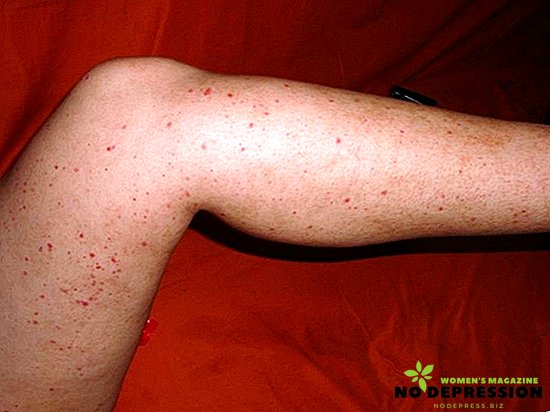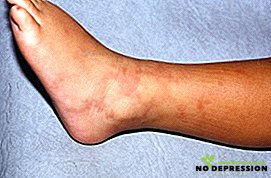Vasculitis is a group of diseases that are accompanied by inflammation and necrosis of vascular tissue. In the absence of proper treatment, the disease can move to other tissues and organs - as a result, it can cause death.

At the moment, doctors and scientists can not accurately determine the cause of inflammation, the mechanism of occurrence. In our material, we consider the symptoms of vasculitis and treatment principles.
What types of the disease exist
Vasculitis is classified by many parameters. Let's analyze these points in more detail.
If we talk about the root cause, then there are such forms of the disease as:
- Primary. In this case, the defeat of the walls of blood vessels occurs for unknown reasons, often occurring - a violation of the immune system.
- Secondary. Damage occurs as a response to various infections, such as hepatitis, systemic lesions, reaction to exposure to chemical agents, etc.
The severity of the disease is:
- Easy In this case, a small rash may appear on the body, the general condition does not worsen.
- Medium heavy.
Depending on the type of inflammation of the blood vessels, it is possible to distinguish such forms as:
- Capillary, at which capillary walls become inflamed.
- Arteriolitis is an inflammation of the arteriole walls.
- Arteritis - problems with artery walls.
- Phlebitis, in which there is inflammation of the venous walls.
Depending on the location of the problem vessels, the following types of this disease can be distinguished:
| The form | Location | Kinds |
|---|---|---|
| Systemic | Inflammation usually covers several departments at once. | Nodular periarteritis Wegener's granulomatosis Giant cell arteritis Behcet syndrome |
| Disease of individual organs | Covers some areas of organs or vessels. | Primary Angiitis CNS Skin lesions Heart failure |
Common symptoms of vasculitis
The symptoms of this disease are varied, but the most characteristic of them is the appearance of a skin rash. The severity of symptoms and the condition of a person depend largely on the disease: its form and type.
For example, a severe form of vasculitis without proper treatment can lead to disability.
Let's take a closer look at all the symptoms.
Rash
The rash may take a different form, but some features may indicate the disease:
- A rash usually appears after an infection.
- It occurs with allergies, any chronic disease.
- It is located quite symmetrically.
- First appears on the legs.
- May cause swelling and necrosis.
The most common in patients with vasculitis rash is manifested by the following types:
 Pink or red spots that do not rise above the skin.
Pink or red spots that do not rise above the skin.- Hemorrhagic purpura. Appear with damage to blood vessels or as a result of hemorrhage. The rash resembles a scarlet stain. Dimensions can reach 1 cm. Over time, they turn blue, then turn yellow.
- Hives. It often occurs on the background of an allergic reaction, may be accompanied by itching or burning sensation.
- Subcutaneous nodes resulting from the uncontrolled growth of the epidermis and connective tissue. The size varies from two millimeters to 2 cm. Such a rash is painful, over time with the appearance of necrosis, the skin darkens.
- Bubbles up to 0.5 cm in size. Filled with clear liquid with droplets of blood.
- Ulcer, erosion. If the subcutaneous nodules were not cured, then over time, erosion or ulcers are formed in their place, which can suppurate upon infection.
Intoxication
When vasculitis is impaired blood circulation, which can cause the appearance of toxins that poison the body. As a result, symptoms such as:
- weakness;
- poor appetite and sharp weight loss;
- drowsiness;
- the appearance of headaches;
- depending on the severity of the disease, the temperature may rise - sometimes up to +40 degrees.
Nervous system damage
Due to exposure to toxins, the following symptoms may occur:
- convulsions;
- fluctuations in the psycho-emotional state;
- muscle weakness;
- cerebral hemorrhage.
Vision problems
Due to blood supply problems, the eyes may be affected, which is manifested by the following symptoms:
- progressive vision loss;
- redness.
Respiratory system
Due to the inflammatory process and impaired permeability of the vascular walls, edema of the respiratory system develops. As a result, it may cause:
- prolonged rhinitis;
- sinusitis and sinusitis;
- destruction of the walls of the sinuses and even the septum of the nose;
- bronchitis or asthma.
Kidney problems
Some varieties of this disease can cause kidney problems. This is all manifested by the following symptoms:
- fever;
- aching lower back pain;
- the presence of blood and protein in the urine.
How is the treatment?
The treatment of this disease is extremely complex - the choice of tactics depends on its type. It is carried out either on an outpatient basis or in a hospital.
Hospitalization is possible in the following cases:
- Medium or severe form of the disease.
- Exacerbation of vasculitis.
- Pregnancy.
- If the child is sick.
In the acute form of vasculitis, the patient should be kept in bed, this will quickly get rid of the rash and stabilize blood circulation.

But also applied and drug therapy. The choice of medication depends on the form and complexity of the disease, is prescribed only by a doctor. For example, with a mild form of vasculitis, the period of taking the drug is about a month, up to six months - with a form of moderate severity and up to 1 year - with a severe one.
During treatment, drugs such as are usually prescribed:
- Anti-inflammatory, which will help remove inflammation, relieve joint pain. For example, Ortofen.
- Antiplatelet or anticoagulants to help prevent blood clots. The cheapest is Aspirin.
- Enterosorbents, binding toxins formed in the intestine. Most often prescribed Nutriklinz.
- Glucocorticosteroids. Such drugs have an anti-inflammatory effect.
- Antihistamines, such as Suprastin. It is prescribed in the presence of an allergic reaction.
In addition, non-drug therapy can be prescribed, which helps to clean the blood of toxins and other substances that lead to a worsening of the disease. There are the following methods:
- Immunosorption. In this case, the venous blood is purified, for which purpose a special apparatus is used.
- Hemosorption. Blood is cleaned through a special installation.
- Plasmapheresis.
But we do not recommend self-treatment of this disease, since taking certain medicinal herbs can cause severe allergies. But in the absence of a negative reaction, some physicians may prescribe herbal medicine using licorice root, train stock, peppermint, calendula.
Diet and proper nutrition
Since vasculitis can cause allergies, in order to prevent such a complication, the following products should be avoided:
 chocolate;
chocolate;- eggs;
- red vegetables and fruits;
- all citrus fruits;
- honey and products based on it;
- products with a high content of stabilizers;
- mushrooms;
- pastry products;
- fried and spicy dishes;
- A large amount of coffee and strong tea.
You should also exclude any other products that may cause allergies.
Complications of vasculitis and prognosis
Projections of this disease largely depend on the age of the patient, the form and type of vasculitis, the presence of complications. Five-year survival with proper treatment is more than 90%. But without therapy, this figure is close to 5%.
In addition, bad forecasts are affected by:
- damage to the central nervous system, kidneys;
- problems with the aorta and vessels;
- diseases of the digestive system;
- age over 50 years.
This indicates that people with such complications need to strictly follow the recommendations of doctors.


 Pink or red spots that do not rise above the skin.
Pink or red spots that do not rise above the skin. chocolate;
chocolate;









